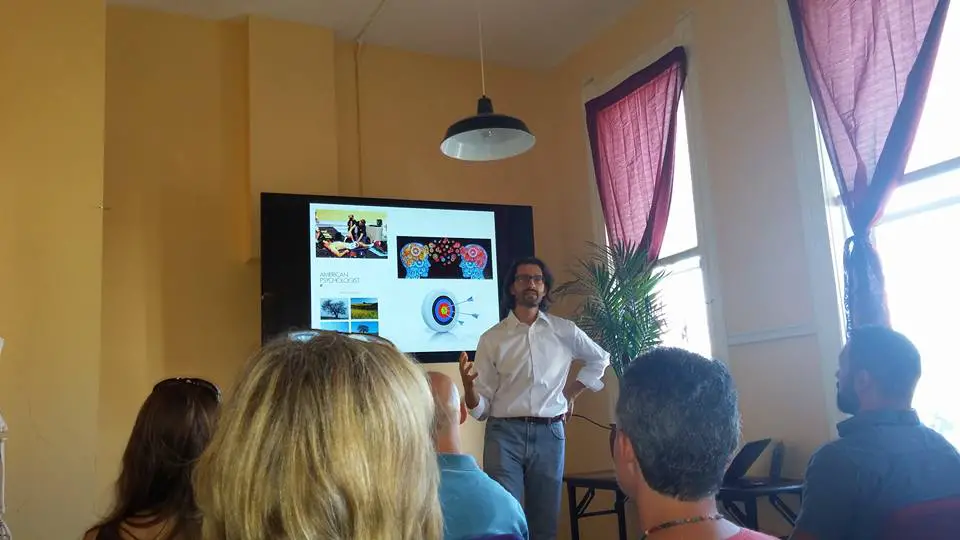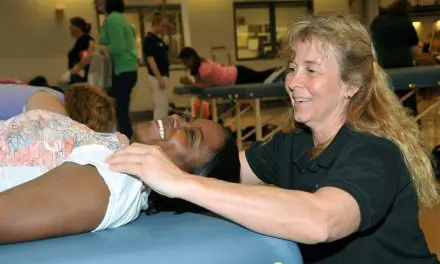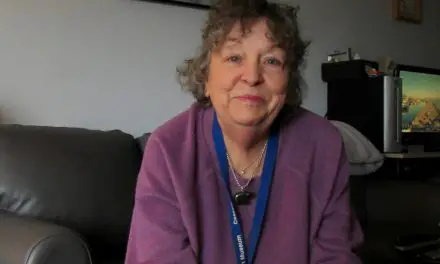Reading and judging an abstract from a research paper is like judging how great or lousy a movie is by watching a two-minute trailer. Thus, there were many different perspectives and opinions on social media about the recent meta-analysis that examined 25 trials about massage therapy’s effects on low back pain, which was discussed here last week.
To sort through the chaos, Dr. Christopher Moyer, who is a psychologist, experienced massage therapy researcher, and meta-analyst, reviewed the full paper by Furlan et al. He has completed studies of massage therapy’s effects on adults, children, and on the stress hormone cortisol. Dr. Moyer is also the co-editor of Massage Therapy: Integrating Research and Practice, which includes a chapter on massage for low back pain authored by members of the research team that just conducted this new review.
Massage & Fitness Magazine: What are some of the common misperceptions massage therapists have about this study after reading the abstract?
Moyer: It has been really interesting to see the reactions of the massage therapy community to this review, and I think there are a number of reasons for that. And I’m not sure it’s that those reactions are misperceptions; I think it would be more accurate to say that, among massage therapists, there have been various interpretations of the study’s conclusions. After all, the study authors state their conclusion very clearly when they say “we have very little confidence that massage is an effective treatment for [low back pain].” But how that conclusion gets interpreted may depend on one’s own understanding of scientific research, their familiarity with low back pain as a clinical condition, and the preexisting beliefs they have about massage therapy as a treatment.
One factor that is likely playing a role in how massage therapists are reacting to this study is the reversal of previous findings. This is a Cochrane review. Cochrane conducts their reviews in an ongoing way; they conduct a review when there is a sufficient number of individual studies to make it practical to do so. This lets them reach a conclusion, although sometimes it will be a tentative conclusion depending on the nature of the evidence. Then, when more studies in the same area have accumulated, they will go back and add that new evidence to the studies that they reviewed previously. This is a perfectly reasonable and progressive way to assess evidence as it accumulates.
When an earlier review is based on a small to medium number of studies, the conclusions will necessarily be tentative, and only a few new studies with divergent results can have a big effect on the bigger picture. In their earlier review of massage therapy for low back pain, they reviewed 13 studies that, taken together, led them to conclude that “massage might be beneficial for patients with subacute and chronic non-specific low-back pain, especially when combined with exercises and education.” That’s a fairly optimistic conclusion.
The updated review adds 12 new studies to the mix, and so the new best estimate of the overall effect should be more precise (unless the larger set of studies are wildly divergent in their individual results, which would be unusual). It seems the most recent data has forced them to temper their previous conclusion. That shouldn’t be too surprising; when the prior estimate is based on a small number of studies, it may only take one or two new negative findings to have a big influence on the estimated average effect across the expanded set of studies. But, this revised conclusion is still bound to take people by surprise, since they have previously been told that the average effect seemed to be quite positive.
Another factor is that the tone of the paper is very formal and circumspect, even for a scientific review. I think this reflects the ‘house style’ of the Cochrane system, in which the study authors stick very closely to the data and engage in very little speculation about various ways in which the data might be interpreted. That’s not meant to be a criticism; in fact, I would say that approach is generally a strength. However, in the present case I think it would have been reasonable for the authors to be slightly more positive about their conclusions, especially about one analysis in particular.
The effect of massage therapy on subacute and chronic pain intensity across short-term time periods (defined as six months or less in this review), when compared with inactive controls, was quite good. Now, that finding needs to be viewed in context – other analyses they performed, on pain-related function and on other types and durations of pain, had meager results. But I also think those other analyses are less interesting than the one concerned with the effect of massage therapy on short-term, subacute low back pain, which might be the most relevant to the majority of situations encountered in clinical practice. That one seems to be to be the most interesting and useful of the multiple analyses they conducted, and based on that I might reach a slightly more optimistic conclusion than they did.
Yet another factor is the nature of low back pain. It is a notoriously difficult condition to treat. Because of this, I think it is encouraging if a treatment shows even a modest effect on this condition. In other words, I think it is reasonable to consider what we know about the condition – in this case that it is chronic, that it comes from wide range of underlying causes, and that it is known to be difficult to treat – to put even a modest finding into context. When the condition being treated has those attributes, even a modest effect might be very valuable.
Finally, the massage therapy profession lacks a research culture. This is not an put down, but simply an observation. Very few people in the profession are experienced with clinical research and how to interpret it, and this is going to cause people to ‘go with their gut’ even more than they otherwise would. I can’t really blame a massage therapist who has had some success in a clinical setting for wanting to reject the conclusions of this paper. I’m not saying that therapist is correct to do so; rather, I’m pointing out that, without a higher level of research literacy in the profession, that type of reaction is to be expected.
Nevertheless, I think the situation is improving. There do seem to be more people in massage therapy who are interested in research and in how it can positively impact the profession, and I will freely admit that several clinicians who discussed this paper on social media gave me some interesting and useful things to consider as I read the paper for myself.
M&F: You’ve read the full paper – does the abstract accurately reflect the study as a whole?
Moyer: Yes, it is accurate. Remember, these are experienced researchers, and they know how to summarize their results accurately. Having said that, I do think there is room for a slightly more positive, hopeful tone. Someone who reads the abstract, especially if they lack a background in research that would help them understand the scientific context in which this was written, might be led to believe that massage therapy is useless for low back pain, and that is that. I think the full set of results leaves open the possibility that massage therapy is effective for certain types of low back pain across specific intervals of time, and that newer studies focused on those particulars would be worth conducting.
M&F: Why do you think the study authors are pessimistic about the results?
Moyer: I think it is more that they are circumspect than pessimistic. Speaking as a scientist, we are very careful to guard against declaring a finding if there is even a small risk of it being a false positive. We never want to say ‘we’ve found something’ and later have it turn out we were wrong when more data comes in. So, I think they are hewing to scientific norms in this regard, and I do not fault them for that; it is important to be careful in science.
M&F: You are also an experienced meta-analyst. Would you have done anything differently if you had been a part of the team that conducted this study?
Moyer: This is a very good study conducted by a team experienced with meta-analytic methods, and meta-analysis is one of the strongest tools in clinical research. I would begin by saying that people in the massage therapy profession should take these findings seriously as the current best evidence addressing the effectiveness of massage therapy for low back pain.
A funny thing that I’ve noticed about meta-analyses is that people tend to take the findings for granted. When one conducts a meta-analysis, it is often to address a fairly broad research question, such as ‘does massage therapy reduce low back pain?’ or ‘does massage therapy reduce depression?’
Clinicians have beliefs, based on their clinical experience and personal investment in the profession, about these types of questions, whereas they are unlikely to have specific beliefs about very specific and technical research questions of the type addressed in individual laboratory studies (e.g., ‘does massage therapy moderate growth hormone activity in professional cyclists following endurance training?’). So what tends to happen, I think, is that the meta-analyst does hundreds of hours of work, using cutting-edge statistical methods to meaningfully combine the results of dozens or even hundreds of individual studies, and arrives at the best scientific answer to an important question.
Then they publish this finding – e.g., massage therapy reduces depression – and clinicians say ‘well of course, we already knew that!’ Except they didn’t know that; they believed it, and the scientific finding – which is the very best evidence now in existence – happens to confirm their belief. Or, the finding contradicts their belief, which leads them to say ‘oh, that finding is obviously wrong.’ This can also motivate them to comb through the study to try to find the ‘mistakes,’ which they would not bother to do if the review had confirmed their belief.
This is natural and to be expected, I think. And people should examine research critically, but they need to be careful to ensure that is, in fact, what they are doing, and that they are not reacting in ways that are really just serving to protect and reinforce their beliefs in contradiction of the evidence.
There are a couple of technical things that I might have done differently, but this is mostly esoteric stuff. I would prefer that the individual studies be weighted by inverse variance than by sample size, as that method tends to yield slightly more accurate estimates of effect. And I would encourage the study authors, if they eventually do another update when there is eventually more data, to consider using psychometric meta-analytic methods, developed by Hunter and Schmidt, that adjust effect size estimates in relation to the reliability and validity of the measurement tools used in the individual studies.
That’s a technical way of saying that the results could be adjusted to account for the less-than-perfect precision of the back pain measurements used in the individual studies. That could yield an even more accurate and informative set of results if the standardized back pain measurements used in the individual studies lack sensitivity in a way that is well-understood and can be quantified.
But again, this is esoteric stuff between scientists. What I wish to emphasize is that this is a fine piece of research conducted by experienced, knowledgeable researchers. It is the best evidence we have addressing the question of whether massage therapy reduces low back pain.
M&F: Should this new evidence influence practice? If so, how?
Moyer: I think it should influence how massage therapists think about practice, but I don’t think it needs to have a significant effect on how most massage therapists practice. If a therapist is doing massage as a treatment for clients/patients with low back pain, it is reasonable to continue doing that, especially if they appear to be getting good results in the clinical setting and if the clients/patients are pleased with the clinical results.
The findings of the study show that massage therapy has a low incidence of adverse outcomes and that it may have effectiveness for reducing subacute and chronic back pain intensity in the short term. In addition, the studies reviewed cannot account for all aspects of massage therapy as practiced in clinical settings. It is possible that a really good massage therapist, using an optimal approach, could be getting much better results than what is represented by the review because that approach is not included in the review, or is included but is being diminished by being averaged together with other noneffective approaches.
I think it is also incumbent upon massage therapists to think about this latest evidence critically, and to consider that maybe massage is not as effective for low back pain as we previously thought. Further, this needs to be reflected accurately in conversations with clients/patients and with other professionals. If a client/patient asks whether massage therapy is likely to help with low back pain, a fair and accurate answer should indicate that the latest research does not strongly support this, though it is also unlikely to have any adverse effects and it may be helpful under the right conditions.
If I suffer from chronic low back pain, I would still consider receiving massage therapy as a treatment even after reading this latest research review. The difference is that I would use this latest information to adjust my expectations. But I would still pursue treatment.
Massage & Fitness Magazine thanks Dr. Moyer for his time and energy for our interview, and Jill Berkana, her staff and students, for inviting Dr. Moyer to speak recently at The Berkana Institute of Massage Therapy in Denver, Colorado.
Here is the full presentation.
A native of San Diego for nearly 40 years, Nick Ng is an editor of Massage & Fitness Magazine, an online publication for manual therapists and the public who want to explore the science behind touch, pain, and exercise, and how to apply that in their hands-on practice or daily lives.
An alumni from San Diego State University with a B.A. in Graphic Communications, Nick also completed his massage therapy training at International Professional School of Bodywork in San Diego in 2014.
When he is not writing or reading, you would likely find him weightlifting at the gym, salsa dancing, or exploring new areas to walk and eat around Southern California.





